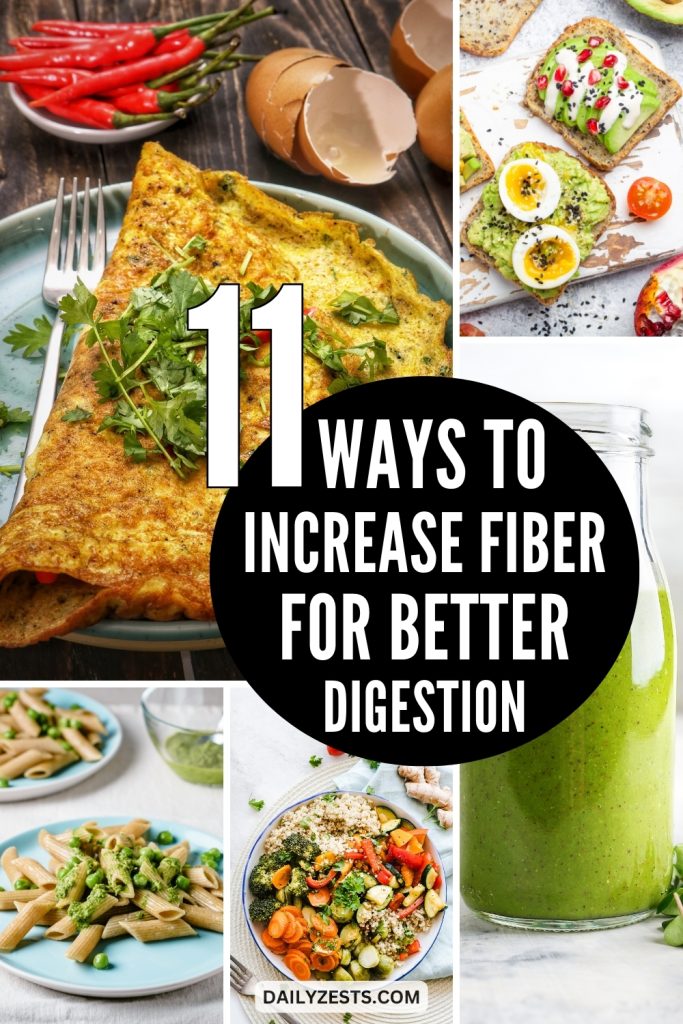Let’s talk about fiber, shall we? It’s not exactly the most glamorous nutrient, but trust me, it’s a total game-changer for your health. Fiber is like the unsung hero of the nutrition world, working quietly behind the scenes to keep your digestion running smoothly, your blood sugar stable, and your gut happy. It can even help with weight management and lower your risk of certain diseases!
But here’s the thing: most of us aren’t getting enough of it. I know I’ve been guilty of neglecting my fiber intake in the past. It’s easy to do when you’re constantly on the go and surrounded by processed foods.
But fear not! Increasing your fiber intake doesn’t have to be complicated or involve choking down bowls of tasteless bran. There are plenty of easy and delicious ways to sneak more fiber into your diet without feeling like you’re sacrificing flavor or enjoyment. Ready to give your gut some love?
Why Fiber is Your Friend: The Benefits
Before we dive into the tips, let’s take a quick look at why fiber is so important:
- Keeps You Regular: Fiber adds bulk to your stool and helps it move smoothly through your digestive system, preventing constipation.
- Supports a Healthy Gut: Fiber feeds the good bacteria in your gut, promoting a healthy gut microbiome.
- Helps Manage Blood Sugar: Fiber slows down the absorption of sugar, preventing blood sugar spikes and crashes.
- Lowers Cholesterol: Certain types of fiber can help lower LDL (“bad”) cholesterol levels.
- Aids in Weight Management: Fiber helps you feel full and satisfied after eating, which can help prevent overeating.
- May Reduce the Risk of Certain Diseases: Studies have linked a high-fiber diet to a reduced risk of heart disease, type 2 diabetes, and certain types of cancer.
How Much Fiber Do You Need?
The recommended daily intake of fiber is around 25-30 grams for adults. However, many people fall short of this goal. It is important to increase your intake slowly to avoid any digestive discomfort.
11 Easy Ways to Boost Your Fiber Intake
Now, let’s get to the practical tips! Here are nine simple ways to add more fiber to your diet.
1. Start Your Day with a Fiber-Rich Breakfast

Breakfast is the perfect opportunity to load up on fiber and set yourself up for a day of digestive success.
Try these high-fiber breakfast ideas:
- Overnight Oats: Combine ½ cup rolled oats (3g fiber), 1 tbsp chia seeds (5g fiber), ½ cup berries (4g fiber), and ½ cup almond milk. Let it sit in the fridge overnight and enjoy a delicious and fiber-packed breakfast in the morning.
- Whole-Grain Cereal with Fruit: Choose a cereal with at least 3 grams of fiber per serving. Add ½ cup of sliced strawberries (2g fiber) and a sprinkle of almonds (3.5g fiber per ¼ cup) for extra nutrients and fiber.
- Breakfast Smoothie: Blend 1 cup of spinach (0.7g fiber), ½ cup of frozen berries (4g fiber), ½ a banana (1.5g fiber), 1 tbsp of almond butter (1.6g fiber), and ½ cup of water or milk.
2. Embrace the Power of Fruits and Vegetables

Fruits and vegetables are naturally packed with fiber. Aim for at least five servings per day.
Here are some easy ways to eat more produce:
- Snack on fruits and veggies: Keep cut-up vegetables like carrots (0.7g fiber per baby carrot), celery (0.6g fiber per stalk), and bell peppers (1g fiber per ½ cup) on hand for easy snacking. Apples (4.5g fiber), bananas (3g fiber), and oranges (3g fiber) are also great portable options.
- Add vegetables to your meals: Toss some spinach into your omelet, add extra veggies to your stir-fries, or load up your sandwiches with lettuce, tomato, and cucumber.
- Make fruits and vegetables the star of the show: Instead of thinking of them as side dishes, try building your meals around them. For example, make a big salad with grilled chicken or fish, or try a vegetable-based soup or stew.
- Try this: Make a big batch of roasted vegetables on the weekend and add them to your meals throughout the week.
3. Choose Whole Grains Over Refined Grains

This is a simple swap that can make a big difference in your fiber intake. Whole grains, like brown rice, quinoa, whole-wheat bread, and whole-grain pasta, contain the entire grain kernel, including the bran and germ, which are the most fiber-rich parts.
Here’s how to make the switch:
- Swap white bread for whole-wheat bread (3g fiber per slice).
- Choose brown rice (3.5g fiber per cup) instead of white rice.
- Try quinoa (5g fiber per cup) or whole-wheat couscous as a side dish.
- Opt for whole-grain pasta (6g fiber per cup) instead of regular pasta.
4. Add Legumes to Your Meals

Beans, lentils, and chickpeas are not only packed with fiber (around 7-9 grams per ½ cup cooked) but also excellent sources of protein and other essential nutrients.
Here are a few ideas:
- Add beans to your salads, soups, or stews.
- Use lentils to make a hearty and flavorful soup or curry.
- Snack on roasted chickpeas for a crunchy and satisfying treat.
- Try a black bean burger: Mash ½ cup of black beans with ¼ cup of cooked brown rice, ¼ cup of chopped onion, and your favorite spices. Form into patties and cook in a pan or bake in the oven.
5. Snack on Nuts and Seeds

Nuts and seeds are delicious, satisfying, and excellent sources of fiber and healthy fats. Keep a bag of mixed nuts or seeds in your desk drawer or purse for a healthy and convenient snack.
Here are some great options:
- Almonds (3.5g fiber per ¼ cup)
- Walnuts (2g fiber per ¼ cup)
- Chia seeds (10g fiber per 2 tbsp)
- Flax seeds (8g fiber per 2 tbsp)
- Pumpkin seeds (1.7g fiber per ¼ cup)
- Sunflower seeds (3g fiber per ¼ cup)
- Try this: Make your own trail mix by combining your favorite nuts, seeds, and dried fruit (in moderation).
6. Read Food Labels

Become a label detective! Pay attention to the fiber content of packaged foods. Look for products that have at least 3 grams of fiber per serving. You might be surprised at how much (or how little) fiber some foods contain. The nutrition facts label is your friend!
7. Don’t Peel Your Fruits and Vegetables (When Appropriate)

The skin of many fruits and vegetables, like apples, pears, and potatoes, is packed with fiber. So, whenever possible, eat your fruits and vegetables with the skin on. Just be sure to wash them thoroughly first.
8. Drink Plenty of Water

Water is essential for proper digestion and helps fiber work its magic. Aim for at least 8 glasses of water per day. Water helps fiber move smoothly through your digestive system, preventing constipation and promoting regularity.
9. Be Mindful of Portion Sizes

Even high-fiber foods can contribute to digestive discomfort if you eat too much of them at once. Pay attention to portion sizes, especially when you’re first increasing your fiber intake. It is best to start slow.
10. Consider a Fiber Supplement (If Needed)

While it’s always best to get your fiber from whole foods, a supplement can be helpful if you’re struggling to meet your daily needs. Talk to your doctor or a registered dietitian before starting a fiber supplement.
11. Increase Fiber Intake Gradually

If you’re not used to eating a lot of fiber, it’s important to increase your intake gradually to avoid digestive discomfort like gas and bloating. Start by adding a few extra grams of fiber per day, and be sure to drink plenty of water to help the fiber move through your system. Your body will adjust over time.
Fiber: Your Gut’s Best Friend
There you have it – eleven simple ways to boost your fiber intake and reap the many health benefits. It’s all about making small, sustainable changes that you can stick with over time. Remember that your gut will thank you for it.
By incorporating these tips into your daily routine, you’ll be well on your way to a happier, healthier gut and a more vibrant you. So, go forth and embrace the power of fiber! What are your favorite high-fiber foods or tips? Share them in the comments below!







